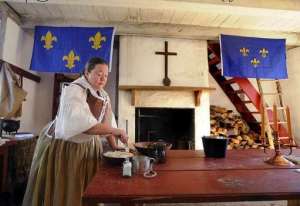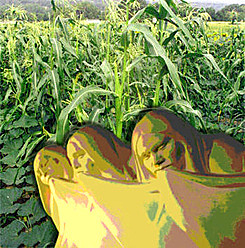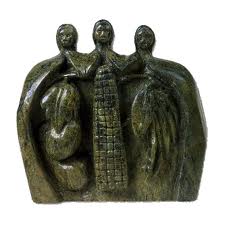Victoria Rumble
, the author of The Historic Foodie on Word Press.com and a published author gave me permission to reprint her articles dealing the the diet of the natives in the Southern region. You may want to click your “favorite” button when you read her blog as she has several articles of interest, not just foods of the 17th and 18th century.Since we live in the heart of Cherokee and Creek region and may members are interested in things Native, I thought you would enjoy the articles.
This is the second part of today’s post. The first dealt with Indians of Maryland, this one concerns the Southern Indians, especially the Creeks. Charles Colcock Jones began his discourse by saying there was a continual and friendly discourse between the families constituting the respective tribes. “Ever ready to assist each other, and entertaining an abiding friendship, the one for the other, the members of the various tribes seemed to Mr. Bartram to constitute one great family, holding all their possessions in common. Theft was almost unknown.”
Animal food of the Southern Indians included buffaloes, deer, bears, beavers, panthers, raccoons, opossums, wild-cats, rabbits, and squirrels, generally killed with bow and arrow. During certain seasons large quantities of meat were obtained, cured, and stored for future use. “All sorts of fishes, turtles, terrapins, oysters, clams, fresh-water mussels, conchs, alligators, and even some varieties of snakes, were eaten, and much time was consumed in the capture of the fishes by means of the bow and arrow, spears, nets, baskets, and wears.”
“Young wasps, white in the comb, were regarded as a dainty morsel. Wild-turkeys, water-fowl, and various birds were eagerly sought after and eaten. In a word, there was but little animal life in the forests or in the waters of the country which the Southern Indian excluded from his food list. Even upon dogs did they sometimes subsist…
Among the vegetables upon which these primitive peoples chiefly relied for sustenance, may be mentioned Indian corn (maize or zea), wild-potatoes, ground-nuts, acorns, walnuts, hickory-nuts, chestnuts, pumpkins, melons, gourds, beans, pulse of various sorts, persimmons, peaches, plums, grapes, and mulberries. The tuberous roots of the smilax were dug up, and while still fresh and full of juice, were chopped up and macerated well in wooden mortars. When thoroughly beaten, this pulpy mass was put in earthen vessels containing clean water. Here it was stirred with wooden paddles or with the hands. The lighter particles, floating upon the top, were poured off. A farinaceous matter was left at the bottom of the vessel; which, when taken out and dried, remained an impalpable powder or farina of a reddish color. Boiled in water, this powder formed a beautiful jelly, which, when sweetened, was both agreeable and nourishing. In combination with corn-flour and when fried in fresh bear’s-grease, it made excellent fritters.”
The dried corn was beaten in a mortar, boiled for hominy, or missed with hickory-nut-milk, walnut-oil, or fresh bear’s-fat, was baked into bread or fried as cakes. Oil was skimmed off the top of water in which walnuts or hickory nuts had been boiled, and stored in covered earthen jars to be used on corn-cakes. Bread was also made from pounded sunflower seeds. Persimmons and grapes were dried and stored for winter. Jones enumerated several ways they obtained salt which he says they had in abundance.
Soruce: Antiquities of the Southern Indians, Particularly of the Georgia Tribes. 1873. NY.
This is part 3 of today’s post on Native foods and was penned in a description of the Indians of North Carolina. Perhaps the reader may wish to compare the subtle differences between the three areas (Maryland, Georgia and neighboring Alabama, and North Carolina). Spelling is unchanged from the original book.
I saw an episode of Preppers about an Apache man named Snake Blocker whose idea of surviving a catastrophe of epic proportions was to live off the land as his ancestors had. He has a better than average chance of doing so, however, his wife wanted no part of his foraged tidbits. I’ve thought about the program, and turned to original 18th century sources for a refresher on native self-reliance.
…Indian foods which are as follows. Venison, and fawns in the Bags, cut out of the doe’s belly; fish of all sorts, the lamprey-eel excepted, and the sturgeon our salt-water Indians will not touch; bear and bever; panther; pole-cat; wild-cat, possum; raccoon; hares, and squirrels, roasted with their Guts in; Snakes, all Indians will not eat them, though some do; All wild fruits that are palatable, some of which they dry and keep against winter, as all sort of fruits, and peaches, which they dry, and make Quiddonies, and Cakes, that are very pleasant, and a little tartish; young Wasps, when they are white in the combs, before they can fly, this is esteemed a Dainty; All sorts of Tortois, and terebins; shell-fish, and stingray, or Scate, dry’d; gourds; melons; cucumbers; squashes; pulses of all sorts; Rockahomine Meal, which is their Maiz, parch’d and pounded into powder; fowl of all sorts, that are eatable; ground-nuts, or wile potato’s; acorns and acorn oil; wild-bulls, beef, mutton, pork, &c. from the English; Indian Corn, or Maiz, made into several sorts of bread; ears of corn roasted in the summer, or preserv’d against winter.”
Source: A New Collection of Voyages and Travels. Ed. Stevens, Ed. 1711. London.



Leave a comment